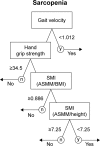Developing sarcopenia criteria and cutoffs for an older Caucasian cohort - a strictly biometrical approach
- PMID: 30122908
- PMCID: PMC6078090
- DOI: 10.2147/CIA.S167899
Developing sarcopenia criteria and cutoffs for an older Caucasian cohort - a strictly biometrical approach
Abstract
Background: The aim of this strictly statistical approach was to provide a figure discrimination in a homogeneous cohort that is based on a main component, which includes disability, physical performance, and autonomy parameters.
Methods: We used data of 939 community-dwelling men aged ≥70 years, living in the area of Erlangen-Nürnberg, Germany. Briefly, we conducted a scaled principal component analysis based on criteria related to "physical function", "disability", "weakness", and "autonomy" to identify men who are likely to have sarcopenia as per the recognized sarcopenia criteria. Next, we applied fast-and-frugal decision trees, logistic regression, and classification and regression decision trees to classify men with and without sarcopenia, applying the 5% prevalence rate identified for this cohort by recent studies.
Results: In summary, the best fast-and-frugal decision trees included gait velocity, handgrip strength, and two skeletal muscle mass indices (SMI) - appendicular skeletal muscle mass (ASMM)/body mass index (BMI) and ASMM/height2. Briefly, men below the cutoff point of 1.012 m/s for gait velocity were directly classified as sarcopenic. Faster men with a handgrip strength of >34.5 kg were excluded from further screening, while their weaker peers were assessed for SMI. Firstly, an ASMM/BMI-based exclusion criterion of >0.886 indicates no sarcopenia; while in men with a lower BMI-based SMI, an ASMM/height2 of <7.25 kg/m2 indicates sarcopenia. Of importance, about 72% of the participants can be classified without an SMI assessment.
Conclusion: The present approach that applied recognized sarcopenia criteria and was based on a predominately functional understanding of sarcopenia provided a simple and feasible decision rule for sarcopenia discrimination. In summary, we consider our approach as a strictly biometrical contribution within the development of sarcopenia screening methods. However, our tool needs to be further evaluated to validate its appropriateness to discriminate sarcopenia in this relevant cohort.
Keywords: Caucasian men aged 70+; classification and regression tree; fast-and-frugal decision trees; sarcopenia cutoff points; sarcopenia screening.
Conflict of interest statement
Disclosure The authors report no conflicts of interest in this work.
Figures


Similar articles
-
Physical function-derived cut-points for the diagnosis of sarcopenia and dynapenia from the Canadian longitudinal study on aging.J Cachexia Sarcopenia Muscle. 2019 Oct;10(5):985-999. doi: 10.1002/jcsm.12462. Epub 2019 Jul 15. J Cachexia Sarcopenia Muscle. 2019. PMID: 31307126 Free PMC article.
-
Prevalence of sarcopenia and sarcopenic obesity in older German men using recognized definitions: high accordance but low overlap!Osteoporos Int. 2017 Jun;28(6):1881-1891. doi: 10.1007/s00198-017-3964-9. Epub 2017 Feb 20. Osteoporos Int. 2017. PMID: 28220197
-
Sarcopenia and sarcopenic obesity among men aged 80 years and older in Beijing: prevalence and its association with functional performance.Geriatr Gerontol Int. 2014 Feb;14 Suppl 1:29-35. doi: 10.1111/ggi.12211. Geriatr Gerontol Int. 2014. PMID: 24450558
-
Cutoff Points for Grip Strength in Screening for Sarcopenia in Community-Dwelling Older-Adults: A Systematic Review.J Nutr Health Aging. 2022;26(5):452-460. doi: 10.1007/s12603-022-1788-6. J Nutr Health Aging. 2022. PMID: 35587757
-
Use of electrical bioimpedance in the assessment of sarcopenia in the older aldults: A scoping review.J Bodyw Mov Ther. 2024 Jul;39:373-381. doi: 10.1016/j.jbmt.2024.02.015. Epub 2024 Mar 18. J Bodyw Mov Ther. 2024. PMID: 38876654
Cited by
-
Anthropometric Measurements for Predicting Low Appendicular Lean Mass Index for the Diagnosis of Sarcopenia: A Machine Learning Model.J Funct Morphol Kinesiol. 2025 Jul 17;10(3):276. doi: 10.3390/jfmk10030276. J Funct Morphol Kinesiol. 2025. PMID: 40700212 Free PMC article.
-
DXA-Derived Indices in the Characterisation of Sarcopenia.Nutrients. 2021 Dec 31;14(1):186. doi: 10.3390/nu14010186. Nutrients. 2021. PMID: 35011061 Free PMC article.
-
Grip strength values and cut-off points based on over 200,000 adults of the German National Cohort - a comparison to the EWGSOP2 cut-off points.Age Ageing. 2023 Jan 8;52(1):afac324. doi: 10.1093/ageing/afac324. Age Ageing. 2023. PMID: 36702514 Free PMC article.
-
Insulin-like growth factor 1 and dehydroepiandrosterone levels in alcoholic liver cirrhosis.JGH Open. 2022 Aug 30;6(10):723-726. doi: 10.1002/jgh3.12809. eCollection 2022 Oct. JGH Open. 2022. PMID: 36262536 Free PMC article.
-
The Favorable Effects of a High-Intensity Resistance Training on Sarcopenia in Older Community-Dwelling Men with Osteosarcopenia: The Randomized Controlled FrOST Study.Clin Interv Aging. 2019 Dec 16;14:2173-2186. doi: 10.2147/CIA.S225618. eCollection 2019. Clin Interv Aging. 2019. PMID: 31908428 Free PMC article. Clinical Trial.
References
-
- Chen LK, Liu LK, Woo J, et al. Sarcopenia in Asia: consensus report of the Asian Working Group for Sarcopenia. J Am Med Dir Assoc. 2014;15(2):95–101. - PubMed
MeSH terms
LinkOut - more resources
Full Text Sources
Other Literature Sources

